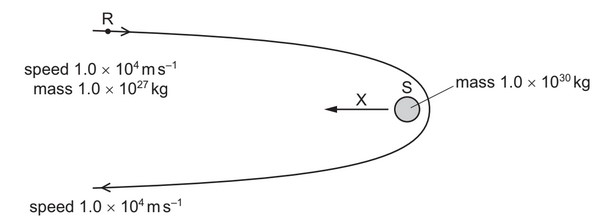Question
A rock of mass 2m, travelling in deep space at velocity v, explodes into two parts of equal mass, one of which is then stationary.
What is the kinetic energy of the moving part after the explosion?
A \(\frac{1}{2}mv^{2}\) B \(mv^{2}\) C \(\frac{3}{2}mv^{2}\) D \(2mv^{2}\)
Answer/Explanation
Ans: D
By the principle of conservation of momentum the velocity of the moving part after the explosion will be given as,
2m v = mv’ + m(0)
v’ = 2v
Hence the kinetic energy of the moving part will be given as,
KE = (1/2) m (2v)^2
KE = \(2mv^{2}\)
Question
A ball of mass 0.16 kg is travelling horizontally at a speed of 20 m s–1. It collides with a wall and rebounds with a speed of 15 m s–1 along its original path. The ball is in contact with the wall for a time of 1.0 ms. What is the average force exerted by the wall on the ball?
A 800 N B 2400 N C 3200 N D 5600 N
Answer/Explanation
Ans:D
The average force exerted is given as the rate of change of momentum hence,
F = m(20 – (-15) )/t
F = 0.16(35)/0.001
F = 5600 N
Question
Which quantities are conserved in an inelastic collision?

Answer/Explanation
Ans:C
Question
A rock R of mass \(1.0 \times 10^{27}\) kg is a large distance from a star S and is travelling at a speed of \(1.0 \times 10^4 m s^{–1}\). The star has mass \(1.0 \times 10^{30}\) kg. The rock travels around the star on the path
shown so that it reverses its direction of motion and, when finally again a large distance from the
star, has the same speed as initially.
Which statement is correct?
A The change in the momentum of S is in the direction of arrow X.
B The change in the velocity of S is approximately 20 m \(s^{–1}\).
C The magnitude of the change of momentum of R is \(10^3\) times greater than the magnitude of the change of momentum of S.
D The momentum of R does not change.
Answer/Explanation
Ans: B
The direction of change in the momentum of S is the opposite direction of X. Hence the option (A) is incorrect.
Question
The diagram shows the masses and velocities of two trolleys that are about to collide.
After the impact they move off together.
What is the kinetic energy lost in the collision?
A 4 J B 6 J C 12 J D 14 J
Answer/Explanation
Ans: B
The final velocity of the trolleys is given by the principle of conservation of momentum, therefore,
v( 2 + 4) = 2*4 + 4*1
v = 2 m/s
The kinetic energy lost is given as,
= (1/2)*2*4^2 + (1/2)*4*1^2 – (1/2)*6*(2)^2 = 6 J
Question
Which statement about a ball that strikes a tennis racket and rebounds is always correct?
A The total kinetic energy of the ball is conserved.
B The total kinetic energy of the system is conserved.
C The total momentum of the ball is conserved.
D The total momentum of the system is conserved.
Answer/Explanation
Ans: D
In the racket ball system, the total momentum of the system is always conserved and the total kinetic energy of the system is not necessarily conserved. Hence the option (D) is correct.
